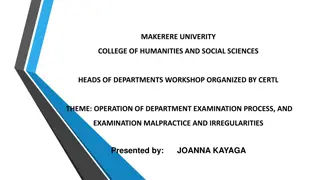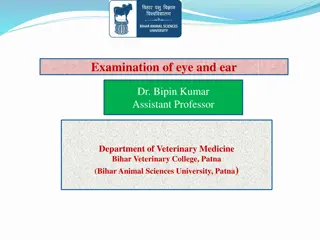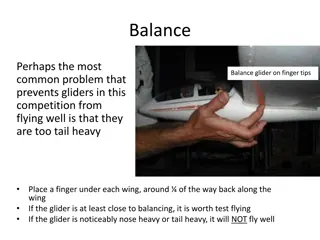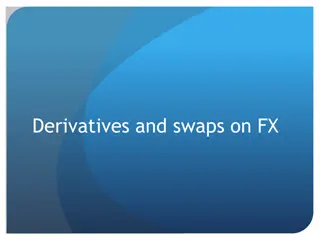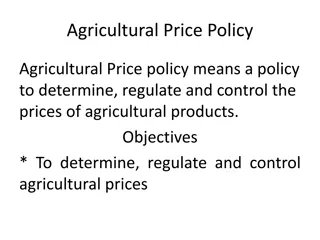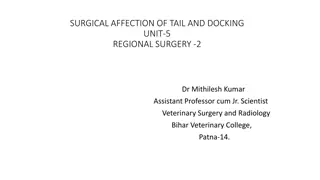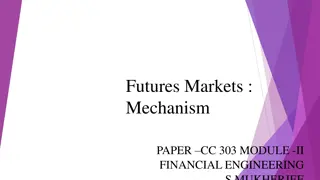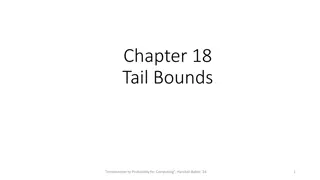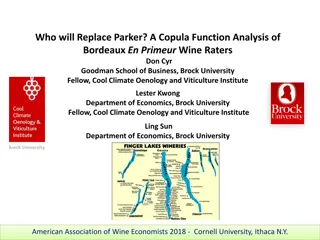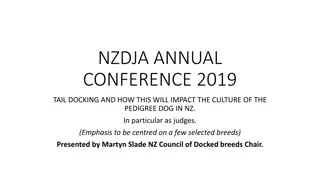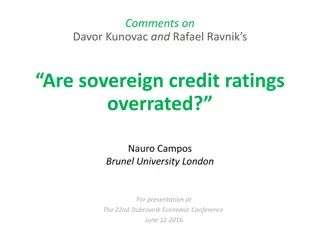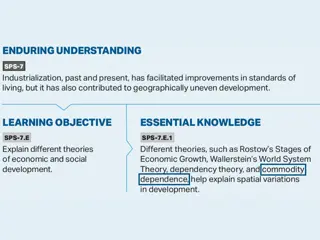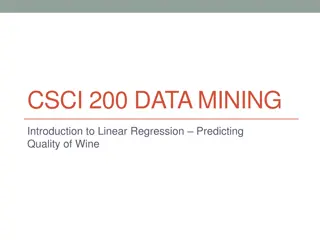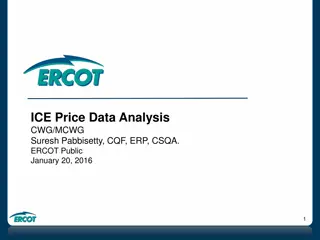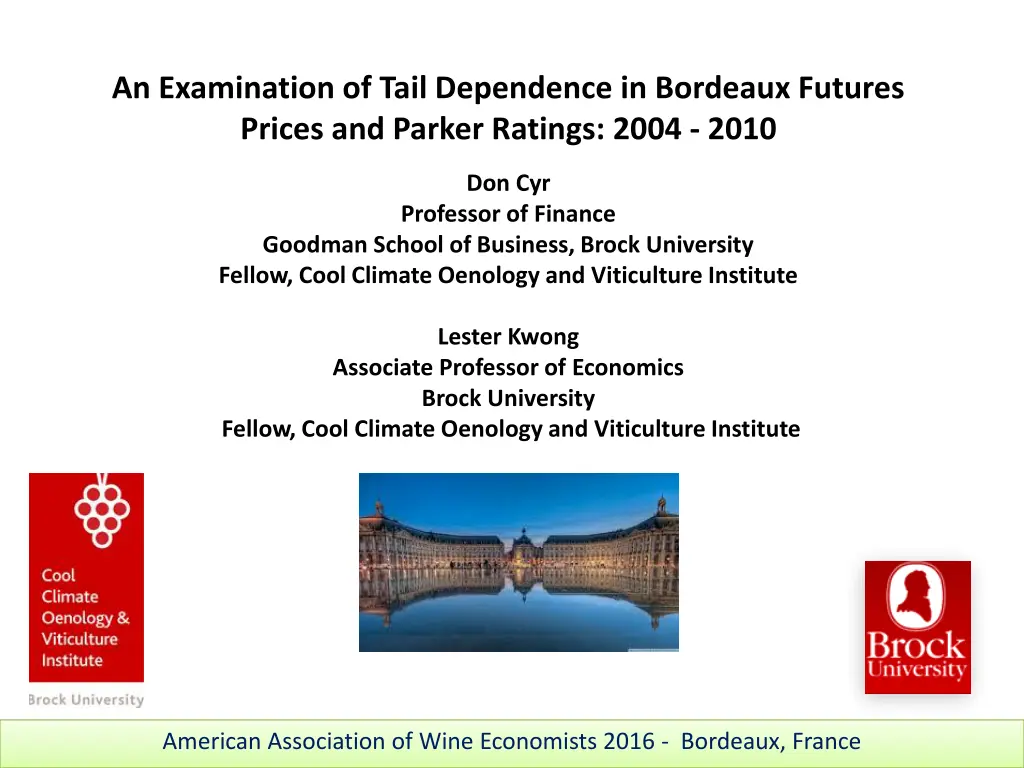
Exploring Tail Dependence in Bordeaux Futures Prices and Parker Ratings
Investigate the relationship between Bordeaux futures prices and Parker ratings from 2004 to 2010. The study by Don Cyr and Lester Kwong delves into the impact of wine critic ratings, en primeur process, and copula functions in modeling nonlinear dependence. Discover the nuances of the Bordeaux en primeur market, the significance of wine critic barrel ratings, and how prices are influenced by Robert Parker Jr.'s ratings. Unveil the intricate dynamics of the Bordeaux wine market through this comprehensive examination.
Uploaded on | 1 Views
Download Presentation

Please find below an Image/Link to download the presentation.
The content on the website is provided AS IS for your information and personal use only. It may not be sold, licensed, or shared on other websites without obtaining consent from the author. If you encounter any issues during the download, it is possible that the publisher has removed the file from their server.
You are allowed to download the files provided on this website for personal or commercial use, subject to the condition that they are used lawfully. All files are the property of their respective owners.
The content on the website is provided AS IS for your information and personal use only. It may not be sold, licensed, or shared on other websites without obtaining consent from the author.
E N D
Presentation Transcript
An Examination of Tail Dependence in Bordeaux Futures Prices and Parker Ratings: 2004 - 2010 Don Cyr Professor of Finance Goodman School of Business, Brock University Fellow, Cool Climate Oenology and Viticulture Institute Lester Kwong Associate Professor of Economics Brock University Fellow, Cool Climate Oenology and Viticulture Institute Brock University American Association of Wine Economists 2016 - Bordeaux, France
Introduction Bordeaux en primeux process Impact of wine critic ratings and wine prices Copula functions and their use in modelling nonlinear dependence Data Preliminary results on copula function modelling Conclusion American Association of Wine Economists 2016 - Bordeaux, France
En Primeur Process The Bordeaux En Primeur Process Existed in France for centuries as a form of futures market Spring of each year, after the prior harvest, merchants, wine critics and trade associations gather to taste and rank barrel samples of wines that are frequently eight to ten months old Wine is then sold ahead of bottling and ultimate release of the vintage, which may be up to two years later Benefit to Purchaser - provides the opportunity for the purchaser to secure a vintage before it is bottled and released, typically at a much lower price Benefit to Producer - cash flow prior to the release and sale of the wine in the retail market Uncertainty - the chateau must decide how much wine to allocate to futures sales as opposed to the retail market, when the wine is bottled and released Risk is mitigated the higher the en primeur price, and prices have been shown to be heavily dependent on the critic barrel scores achieved American Association of Wine Economists 2016 - Bordeaux, France
Wine Critic Barrel Ratings Impact of Parker Barrel Ratings En primeur prices appear to be heavily dependent upon the ranking of the wine based on the barrel tastings, despite the uncertainty remaining, associated with the continued aging process It has long been known in the Bordeaux en primeur market that that the barrel scores of the prestigious wine critic Robert Parker Jr. have had a great influence on the en primeur price offering by the chateaux Parker s ratings have been largely viewed as the authority on Bordeaux en primeur wines Noparumpa et al. (2015), Ali et al. (2010), Ashenfelter, (2010), Jones and Storchmann, (2001). American Association of Wine Economists 2016 - Bordeaux, France
Wine Critic Barrel Ratings Impact of Wine Critics Ratings on Wine Prices A fairly large body of literature deals with the impact of the ratings of wine critics on the demand for wine and wine prices. Studies of this nature have been carried out for wines originating from several countries and over different time periods Over 60 studies and 180 hedonic wine price models over a 20 year period..... The research identifies that the relation between the price of wine and its sensory quality rating is a moderate partial correlation of +0.30. Oczkowski, E., & Doucouliagos, H. (2015). Wine prices and quality ratings: A meta- regression analysis. American Journal of Agricultural Economics, 97(1), 103-121. American Association of Wine Economists 2016 - Bordeaux, France
Wine Critic Barrel Ratings Noparumpa, T., Kazaz, B., and Webster, S. (2015), Wine futures and advanced selling under quality uncertainty , Manufacturing & Service Operations Management. 17(3), 1-16 Notes some non linearity in the relationship of Parker ratings and wine prices American Association of Wine Economists 2011 - Bolzano, Italy
Model Risk Model Risk Risk due to assumptions regarding the fundamental dependence structure between variables and its stationarity. Generally a regression analysis is used, assuming the dependence structure is captured fairly well by linear correlation. It appears that this is not often the case. One solution to the issue is the use of copula functions to fit multivariate distributions, incorporating nonlinear dependence Useful for capturing tail dependence higher correlation at the tails of the univariate distributions comprising the multivariate distribution Aside: Interesting connection between copula function modelling and the 2008 Financial Crisis - the incorrect use of the Gaussian copula to model CDO s comprised of multiple mortgages: Salmon, F. (2009). Recipe for Disaster: The Formula That Killed Wall Street, Wired Magazine http://archive.wired.com/techbiz/it/magazine/17-03/wp_quant?currentPage=all American Association of Wine Economists 2016 - Bordeaux, France
COPULA Functions Based upon Sklar s Theorem (1959) If F is a joint distribution function of m random variables (y1,...,ym) with marginal distributions F1,......,Fm Then there exists an m-dimensional copula C:[0,1]m [0,1] (from the unit m-cube to the unit interval) which satisfies the following conditions: 1. C (1,...,1,an, 1,...,1) = an for every n m and for all an in [0,1] If the realizations of m-1 variables are known, each with a probability of one, then the joint probability of the m outcomes is the same as the probability of the remaining uncertain outcomes. 2. C(a1,...,am) = 0 if an = 0 for any n m The joint probability of all outcomes is zero if the marginal probability of any outcome is zero. 3. C is m-increasing C-volume of any m-dimensional interval is non-negative. American Association of Wine Economists 2016 - Bordeaux, France
COPULA Functions Sklar s Theorem (1959) Given F (y1,...,ym) with univariate marginal distributions F1(y1),...,Fm(ym) and inverse functions F1-1,..., Fm-1, then y1 = F1-1(u1)~F1,..., ym = Fm-1(um)~Fm Where u1,...,um are uniformly distributed variates. F(y1,...,ym) = F(F1-1(u1),..., Fm-1(um)) = Pr[U1 u1,..., Um um] = C(u1,...,um) Is the unique copula function associated with the distribution function and (F1(y1),...,Fm(ym)) ~ C and if U ~ C, then (F1-1(u1),..., Fm-1(um)) ~ F Essentially Copulas can be used to express a mutivariate distribution in terms of its marginal distributions! American Association of Wine Economists 2016 - Bordeaux, France
COPULA Functions Sklar s Theorem (1959) For an m-variate function F, the copula associated with F is a distribution function C:[0,1]m [0,1] that satisfies. F (y1,...,ym) = C (F1(y1),...,Fm(ym); ) Where is a vector of parameters called the dependence parameter which measures dependence between the marginals. In bivariate applications is typically a scalar. The joint distribution is expressed in terms of its respective marginal distributions and a function C that binds them together. This allows for the consideration of marginal distributions and dependence as two separate but related issues. American Association of Wine Economists 2016 - Bordeaux, France
COPULA Functions Application of Copula Functions For a variety of reasons, largely due to the high dimensionality of m 3 copula estimation, most research has focused on bivariate parametric copulas. Parametric copulas -Implicit (Gaussian and Student t copula) implied by known multivariate distribution functions and do not have simple closed forms. -Explicit (Archimedian Copulas) simple closed forms. Form and relationship of parameters to Spearman correlation American Association of Wine Economists 2016 - Bordeaux, France
COPULA Functions Two Parametric Families of Copula Functions are commonly used. 1. ELLIPTICAL COPULAS Can capture some degree of tail dependence but are limited in that they are symmetric. Tend to under estimate tail dependence if it is asymmetric. Gaussian (Normal) Copula Student-T Copula More flexible than the Gaussian copula because It does not assume that uncorrelated variables are independent. American Association of Wine Economists 2016 - Bordeaux, France
COPULA Functions ARCHIMEDIAN COPULAS allow for a wider variety of dependence structures, particularly asymmetric Clayton Copula Greater dependence in the lower tail. Gumbel Copula Greater dependence in the upper tail. Frank Copula Greater correlation in the middle section than in the tails. American Association of Wine Economists 2016 - Bordeaux, France
COPULA Functions Clayton and Gumbel Copulas can also be estimated as transformations of the variables (u, v) by taking one or both of the variables and transforming them as 1-u and/or 1-v, resulting in three additional patterns that can be tested. This provides for directional patterns of 1, 2, 3 and 4. American Association of Wine Economists 2016 - Bordeaux, France
Data Database of en primeur prices along with wine critics ratings 2004 current http://www.bordoverview.com Bolomey Wijnimport Amsterdam wine sellers 2004 through 2010 was chosen as the period of study as it reflects a time period starting from the renown 2005 harvest and carrying through 2010 of a stable sustained bull run in futures prices. It has been alluded to that Parker s barrel ratings had a significant impact on rising en primeur prices. After 2010 (until 2014) lower sales plagued the market along with downward pressure on prices. In additiion 2003 Parker s barrel ratings were released after the en primeur prices were set by chateaux (Ali et al., 2010) American Association of Wine Economists 2016 - Bordeaux, France
Data and Analysis Data is also provided for left bank ( Cabernet Sauvignon dominant) and right bank (Merlot dominant) wines Jones and Storchman (2001) - Show less sensitivity of wine prices to Parker ratings in the case of wines with a higher share of Merlot grape than Cabernet Sauvignon. Screenshot of database: Copula function models were estimated for each of the years 2004 2010 and for left and right bank in each case, using Vose ModelRisk software. www.vosesoftware.com American Association of Wine Economists 2016 - Bordeaux, France
Goodness of Fit Tests for Copulas Standard Approach to Copula Function Modelling: Fit several copula functions to the data and apply maximum likelihood goodness- of-fit tests to see which function models the dependency structure relatively better. Information Criteria Tests (varying penalties for additional parameters) Akaike Information Criteria (AIC) Bayesian (Schwartz) Information Criteria (BIC) Hannan-Quinn Information Criteria (HQIC) Problem is that they do not provide the power of the decision rule. American Association of Wine Economists 2016 - Bordeaux, France
Goodness of Fit Tests for Copulas A few goodness of fit tests have recently been developed for copula functions but significant issues still remain: Problematic due to the high dimensionality of the problem. Full multivariate approach - Panchenco (2005) Physica A Consequently there are approaches that attempt to reduce the problem from a multivariate to a univariate problem: Berg and Batten (2005) Norwegian Computing Centre Genest, Quessy and Remillard (2006) Scandinavian Journal of Statistics However the power of the tests appear to differ with sample size, dimensionality and copula function being tested: Berg, D. (2009). Copula goodness-of-fit testing: an overview and power comparison. The European Journal of Finance, 15(7-8), 675-701 Fermanian, J. D. (2013). An overview of the goodness-of-fit test problem for copulas. In Copulae in Mathematical and Quantitative Finance (pp. 61-89). Springer Berlin Heidelberg. American Association of Wine Economists 2016 - Bordeaux, France
Results Used ModelRisk Software to estimate traditional Copula Functions maximum likelihood estimation of copula function parameters used to identify best fit. Clayton Frank Gumbel Normal T American Association of Wine Economists 2016 - Bordeaux, France
Results 2005 example (combined left and right bank) Gumbel copula provided best fit identifying tail dependence in high values American Association of Wine Economists 2016 - Bordeaux, France
Results 2009 example (combined left and right bank) Clayton copula (direction 4) provided best fit. Again capturing tail dependence at higher values. American Association of Wine Economists 2016 - Bordeaux, France
Results Year Left Bank Right Bank Combined 2004 81 obs. 80 obs. 2005 150 obs. 149 obs. 2006 85 obs. 98 obs. American Association of Wine Economists 2016 - Bordeaux, France
Results Year Left Bank Right Bank Combined 2007 98 obs. 91 obs. 2008 109 obs. 105 obs. 2009 114 obs. 130 obs. 2010 115 obs. 110 obs. American Association of Wine Economists 2016 - Bordeaux, France
Results In general the Gumbel or inverted (direction 4) Clayton Copula appears to best describe the bivariate relationship of Parker barrel ratings and en primeur prices, indicating tail dependence in the form of higher correlation between high ratings and high prices. The prices of lower rated wines have a lower correlation with low Parker ratings Results are consistent regardless of whether AIC, SIC or HQIC likelihood measures are used. Some evidence that the tail dependence for the left bank tends to be stronger than that for the right bank data. American Association of Wine Economists 2016 - Bordeaux, France
Future Research Database also consists of rankings by other wine critics Neal Martin Jancis Robinson Tim Atkin Michel Bettane and Thierry Desseauve James Suckling Jeff Leve Decanter wine magazine critics La Revue du Vin de France Jane Anson Perswin Rene Gabriel American Association of Wine Economists 2016 - Bordeaux, France
Future Research Ashton, R. H. (2012). Reliability and Consensus of Experienced Wine Judges: Expertise Within and Between? Journal of Wine Economics, 7(01), 70-87.. - Mean reliability between judges is .5 across various studies. Cardebat, J. M., & Livat, F. (2016). Wine experts rating: a matter of taste?. International Journal of Wine Business Research, 28(1), 43-58. Variation might be explained by taste preferences of critics Multivariate copula function could be attempted using addition expert rating or combining ratings: Cardebat, J. M., & Paroissien, E. (2015). Standardizing expert wine scores: An application for Bordeaux en primeur. Journal of Wine Economics, 10(03), 329-348. American Association of Wine Economists 2016 - Bordeaux, France
The End American Association of Wine Economists 2016 - Bordeaux, France


